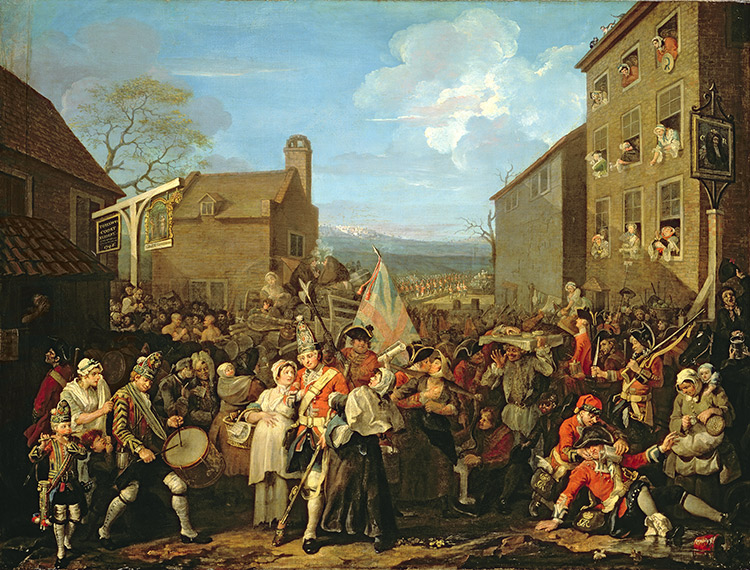This visit to the Foundling Museum almost seems like a companion piece to my visit to the Bedlam Museum of the Mind. Both are long-running institutions that are still running, both have opened a museum/art gallery and both have been refurbished recently.
The Foundling Hospital, now the Coram Institute, was founded by Thomas Coram, a retired sea captain who was shocked by the child poverty of the city he had returned to, viewing the child poverty as both inhuman suffering and also a waste of potential human resources.
He took twelve years petitioning and gaining influential supporters before building a large semi-rural home for unwanted girls and boys where he would train them to become maids and sailors. To keep the enterprise afloat, he would have visiting days (much like Bedlam) where the wealthy could pay to see the children.
He was also supported by artists and musicians. Hogarth painted a number if pictures for the hospital and encouraged other artists to do the same. The Foundling Hospital was at one point the closest thing London had to an art gallery. Handel also performed ‘Messiah’ in the chapel after it had flopped in the Covent Garden Theatre. The piece was a success in the chapel and the piece has become linked to the Foundling Hospital ever since.
The museum tells this story very quickly. Where the Bedlam Museum of the Mind had a through narrative that asked very interesting questions about whether mental health diagnosis and care has really evolved in time, the Foundling Museum just arranges a few objects together and plonks them there.
Some of these objects are really interesting. There was Thomas Coram’s notebook where he registered the various titled people he had asked help from, interesting to note that he targeted women. There is also the registration notes and keepsakes that came with the children. Children left at the Hospital were registered with some cloth or an object so that if the parents’ fortunes changed they could pick their child up by describing it. Very few children were ever picked up and it is very moving seeing all the odds and ends, from beer labels and gaming chips, to broaches and comfort blankets. It’s also interesting seeing these items of everyday 18th Century life.
Children entering the Hospital had their names changed and their are many early names of children on the wall. I looked at these a long time, I wished I had written them down because they are gold. Some are named after famous people (there’s a William Hogarth) some have bits of famous names (Fredrick Wilkes) and some have names from an 18th Century novel (Nathaniel Clusterbucket).
Then there’s a bit with some talking heads describing what it was like being a foundling in the later stages, it would appear it was full of sunshine and roses. And that’s it.. that’s the history. No interesting questions about how social services acts now compares to then, no introspection about the huge death rate of the early hospital or the abuses people made in the name of the hospital (I recommend anyone to read ‘Coram Boy’ to read about those) - that’s the history done.
All that’s left is art. My favourite was Hogarth’s ‘March to Finchley’, it’s a busy painting of soldiers going off to muster against the Jacobites in the ’45 and is full of life and detail. I was even more pleased with how the Hospital received it. Hogarth had put out a lottery to win the painting but so few people bought tickets to for it that he dumped over a hundred with the hospital so they won it.
Hogarth’s portrait of Thomas Coram was as warm and human as I had been informed, his painting of Moses was as constipated as I had expected and the other portraits were a mushy, slushy, faded Reynolds type.
The boardroom was a green, grand affair with mouldings that would not have looked out of place at Strawberry Hill, it also included paintings of other charitable London institutions, including Bedlam. I was interested to be told that the entire building had been further in the field and had been taken apart and carefully reconstructed where it now stands, that’s interesting.
The art project/exhibition that they were holding was called ‘Found’, it consisted of found art. I don’t get art very well; I like a story being told and I’m fond of impressionistic effects of air and light but some magazines Jarvis Cocker found in Romania or a stick someone used to sit paint doesn’t wake my sensibilities much. I looked at reviews, apparently it was pretty special but it takes someone of a more visual (and less verbal) bent to appreciate it.
Finally, there is the Handel room. Four comfortable chairs with speakers in it play bits of Handel on request (without a volume adjuster) and the cases have Handel’s bits and bobs, including his will and some of his book collection. If there was something I could take with me it would probably be ‘The March to Finchley’ but Handel’s books would have been a second.
I had been planning on going to the Foundling Hospital for several years but was put off by the £10 price tag. I would say that if I were to recommend an institution based museum I would definitely recommend the Bedlam Museum of the Mind over the Foundling, it was far more incisive and confrontational in the way it told its story - but the Foundling was a good afternoon nonetheless.





